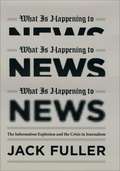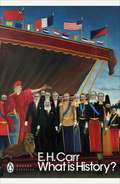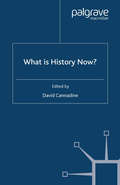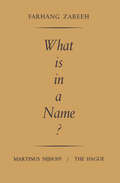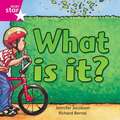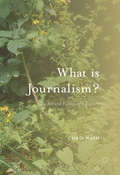- Table View
- List View
What Is Good Writing?
by Geoffrey HuckThough we all think we know what good writing is when we see it, it's difficult to define it precisely; and without a satisfactory definition, it becomes problematical to assess as well as to teach. In What Is Good Writing?, Geoffrey J. Huck advances the contemporary debate on writing achievement by drawing on empirical research in linguistics and the other cognitive sciences that shed light on the development of fluency in language. The utility of defining "good writing" as "fluent writing" or writing that is on par with the typical fluency in speech attained by normal adults, is demonstrated by the progress it permits in evaluating the success of current writing programs in school and university--programs which, for the most part, have proved unable to deliver writing assessments that are both valid and reliable. Huck advances an alternative approach that rests on more scientific footing. He explains why reading is key to good writing and why standard composition programs often do not live up to their aspirations.
What Is Happening to News: The Information Explosion and the Crisis in Journalism
by Jack FullerAcross America, newspapers that have defined their cities for over a century are rapidly failing, their circulations plummeting even as opinion-soaked web outlets like the Huffington Post thrive. Meanwhile, nightly news programs shock viewers with stories of horrific crime and celebrity scandal, while the smug sarcasm and shouting of pundits like Glenn Beck and Keith Olbermann dominate cable television. Is it any wonder that young people are turning away from the news entirely, trusting comedians like Jon Stewart as their primary source of information on current events? In the face of all the problems plaguing serious news, What Is Happening to News explores the crucial question of how journalism lost its way—and who is responsible for the ragged retreat from its great traditions. Veteran editor and newspaperman Jack Fuller locates the surprising sources of change where no one has thought to look before: in the collision between a revolutionary new information age and a human brain that is still wired for the threats faced by our prehistoric ancestors. Drawing on the dramatic recent discoveries of neuroscience, Fuller explains why the information overload of contemporary life makes us dramatically more receptive to sensational news, while rendering the staid, objective voice of standard journalism ineffective. Throw in a growing distrust of experts and authority, ably capitalized on by blogs and other interactive media, and the result is a toxic mix that threatens to prove fatal to journalism as we know it. For every reader troubled by what has become of news—and worried about what the future may hold—What Is Happening to News not only offers unprecedented insight into the causes of change but also clear guidance, strongly rooted in the precepts of ethical journalism, on how journalists can adapt to this new environment while still providing the information necessary to a functioning democracy.
What Is Happening to News: The Information Explosion and the Crisis in Journalism
by Jack FullerAcross America, newspapers that have defined their cities for over a century are rapidly failing, their circulations plummeting even as opinion-soaked web outlets like the Huffington Post thrive. Meanwhile, nightly news programs shock viewers with stories of horrific crime and celebrity scandal, while the smug sarcasm and shouting of pundits like Glenn Beck and Keith Olbermann dominate cable television. Is it any wonder that young people are turning away from the news entirely, trusting comedians like Jon Stewart as their primary source of information on current events? In the face of all the problems plaguing serious news, What Is Happening to News explores the crucial question of how journalism lost its way—and who is responsible for the ragged retreat from its great traditions. Veteran editor and newspaperman Jack Fuller locates the surprising sources of change where no one has thought to look before: in the collision between a revolutionary new information age and a human brain that is still wired for the threats faced by our prehistoric ancestors. Drawing on the dramatic recent discoveries of neuroscience, Fuller explains why the information overload of contemporary life makes us dramatically more receptive to sensational news, while rendering the staid, objective voice of standard journalism ineffective. Throw in a growing distrust of experts and authority, ably capitalized on by blogs and other interactive media, and the result is a toxic mix that threatens to prove fatal to journalism as we know it. For every reader troubled by what has become of news—and worried about what the future may hold—What Is Happening to News not only offers unprecedented insight into the causes of change but also clear guidance, strongly rooted in the precepts of ethical journalism, on how journalists can adapt to this new environment while still providing the information necessary to a functioning democracy.
What Is Happening to News: The Information Explosion and the Crisis in Journalism
by Jack FullerAcross America, newspapers that have defined their cities for over a century are rapidly failing, their circulations plummeting even as opinion-soaked web outlets like the Huffington Post thrive. Meanwhile, nightly news programs shock viewers with stories of horrific crime and celebrity scandal, while the smug sarcasm and shouting of pundits like Glenn Beck and Keith Olbermann dominate cable television. Is it any wonder that young people are turning away from the news entirely, trusting comedians like Jon Stewart as their primary source of information on current events? In the face of all the problems plaguing serious news, What Is Happening to News explores the crucial question of how journalism lost its way—and who is responsible for the ragged retreat from its great traditions. Veteran editor and newspaperman Jack Fuller locates the surprising sources of change where no one has thought to look before: in the collision between a revolutionary new information age and a human brain that is still wired for the threats faced by our prehistoric ancestors. Drawing on the dramatic recent discoveries of neuroscience, Fuller explains why the information overload of contemporary life makes us dramatically more receptive to sensational news, while rendering the staid, objective voice of standard journalism ineffective. Throw in a growing distrust of experts and authority, ably capitalized on by blogs and other interactive media, and the result is a toxic mix that threatens to prove fatal to journalism as we know it. For every reader troubled by what has become of news—and worried about what the future may hold—What Is Happening to News not only offers unprecedented insight into the causes of change but also clear guidance, strongly rooted in the precepts of ethical journalism, on how journalists can adapt to this new environment while still providing the information necessary to a functioning democracy.
What is History?: The George Macaulay Trevelyan Lectures Delivered In The University Of Cambridge January-march 1961 (Penguin Modern Classics)
by E. H. Carr'Not only one of our most distinguished historians but also one of the most valuable contributors to historical theory' SpectatorIn formulating an answer to the question of 'What is History', Carr argues that the 'facts' of history are simply those which historians have chosen to focus on. All historical facts come to us as a result of interpretive choices by historians influenced by the standards of their age.Now for the first time in Penguin Modern Classics, with an introduction by Richard J. Evans, author of the Third Reich trilogy.
What Is History For?: Johann Gustav Droysen and the Functions of Historiography (Making Sense of History #17)
by Arthur Alfaix AssisA scholar of Hellenistic and Prussian history, Droysen developed a historical theory that at the time was unprecedented in range and depth, and which remains to the present day a valuable key for understanding history as both an idea and a professional practice. Arthur Alfaix Assis interprets Droysen’s theoretical project as an attempt to redefine the function of historiography within the context of a rising criticism of exemplar theories of history, and focuses on Droysen’s claim that the goal underlying historical writing and reading should be the development of the subjective capacity to think historically. In addition, Assis examines the connections and disconnections between Droysen’s theory of historical thinking, his practice of historical thought, and his political activism. Ultimately, Assis not only shows how Droysen helped reinvent the relationship between historical knowledge and human agency, but also traces some of the contradictions and limitations inherent to that project.
What is History For?
by Beverley SouthgateAn experienced author of history and theory presents this examination of the purpose of history at a time when recent debates have rendered the question 'what is history for?' of utmost importance.Charting the development of historical studies and examining how history has been used, this study is exceptional in its focus on the future of the subject as well as its past. It is argued that history in the twenty-first century must adopt a radical and morally therapeutic role instead of studying for 'its own sake'.Providing examples of his vision of 'history in post-modernity', Beverley Southgate focuses on the work of four major historians, including up-to-date publications: Robert A. Rosenstone's study of Americans living in nineteenth-century Japan Peter Novick's work on the Holocaust Sven Lindgvist's A History of Bombing Tzvetan Todorov's recently published work on the twentieth century. This makes compulsive reading for all students of history, cultural studies and the general reader, as notions of historical truth and the reality of the past are questioned, and it becomes vital to rethink history's function and renegotiate its uses for the postmodern age.
What is History For?
by Beverley SouthgateAn experienced author of history and theory presents this examination of the purpose of history at a time when recent debates have rendered the question 'what is history for?' of utmost importance.Charting the development of historical studies and examining how history has been used, this study is exceptional in its focus on the future of the subject as well as its past. It is argued that history in the twenty-first century must adopt a radical and morally therapeutic role instead of studying for 'its own sake'.Providing examples of his vision of 'history in post-modernity', Beverley Southgate focuses on the work of four major historians, including up-to-date publications: Robert A. Rosenstone's study of Americans living in nineteenth-century Japan Peter Novick's work on the Holocaust Sven Lindgvist's A History of Bombing Tzvetan Todorov's recently published work on the twentieth century. This makes compulsive reading for all students of history, cultural studies and the general reader, as notions of historical truth and the reality of the past are questioned, and it becomes vital to rethink history's function and renegotiate its uses for the postmodern age.
What is History Now?
by D. CannadineE. H. Carr's What is History? was originally published by Macmillan in 1961. Since then it has sold hundreds of thousands of copies throughout the world. In this book, ten internationally renowned scholars, writing from a range of historical vantage points, answer Carr's question for a new generation of historians: What does it mean to study history at the start of the Twenty-first century? This volume stands alongside Carr's classic, paying tribute to his seminal enquiry while moving the debate into new territory, to ensure its freshness and relevance for a new century of historical study.
What Is History Now? (PDF)
by David CannadineE. H. Carr's What is History? was originally published by Macmillan in 1961. Since then it has sold hundreds of thousands of copies throughout the world. In this book, ten internationally renowned scholars, writing from a range of historical vantage points, answer Carr's question for a new generation of historians: What does it mean to study history at the start of the Twenty-first century? This volume stands alongside Carr's classic, paying tribute to his seminal enquiry while moving the debate into new territory, to ensure its freshness and relevance for a new century of historical study.
What Is History Now? (PDF)
by David CannadineE. H. Carr's What is History? was originally published by Macmillan in 1961. Since then it has sold hundreds of thousands of copies throughout the world. In this book, ten internationally renowned scholars, writing from a range of historical vantage points, answer Carr's question for a new generation of historians: What does it mean to study history at the start of the Twenty-first century? This volume stands alongside Carr's classic, paying tribute to his seminal enquiry while moving the debate into new territory, to ensure its freshness and relevance for a new century of historical study.
What is Intellectual History? (What is History?)
by Richard WhatmoreWhat is intellectual history? Those who practice intellectual history have described themselves as eavesdroppers upon the conversations of the past, explorers of alien ideological worlds, and translators between historic societies and our own, while their critics have often derided them as narrow-mindedly studying the ideas of dead white men. Some consider the discipline to be among the most important in the humanities and social sciences because it facilitates a better understanding of contemporary ideological programmes and facilitates their rational evaluation.In this engaging and refreshing introduction to the field, Richard Whatmore begins by examining the historical development of intellectual history, before dissecting its various methodological debates. He presents various alternative ways in which we should think about intellectual history, as well as presenting his own very clear definition of the field. Drawing on a wide range of historical examples, Whatmore shows how ideas - philosophical, political, religious, scientific, artistic - originated in their historical context and how they were both shaped by, and helped to shape, the societies in which they originated. He ends by casting a critical eye over the current state of intellectual history, and a brief discussion of how it might develop in the future.What is Intellectual History? will become an essential textbook for scholars and students of intellectual history, philosophy, politics, and the humanities.
What Is It? (Rigby Star Independent #Pink Reader 7)
by Jennifer JacobsonWhat are these things that you can see?
What is Journalism?: The Art and Politics of a Rupture
by Chris NashThis book argues that journalism should treat itself as an academic discipline on a par with history, geography and sociology, and as an art form in its own right. Time, space, social relations and imagination are intrinsic to journalism. Chris Nash takes the major flaws attributed to journalism by its critics—a crude empiricism driven by an un-reflexive ‘news sense’; a narrow focus on a de-contextualised, transient present; and a too intimate familiarity with powerful sources—and treats them as methodological challenges. Drawing on the conceptual frameworks of Pierre Bourdieu, David Harvey, Henri Lefebvre, Michel-Rolph Trouillot and Gaye Tuchman, he explores the ways in which rigorous journalism practice can be theorised to meet these challenges. The argument proceeds through detailed case studies of work by two leading iconoclasts—the artist Hans Haacke and the 20th century journalist I.F. Stone. This deeply provocative and original study concludes that the academic understanding of journalism is fifty years behind its practice, and that it is long past time for scholars and practitioners to think about journalism as a disciplinary research practice.Drawing on an award-winning professional career and over three decades teaching journalism practice and theory, Chris Nash makes these ideas accessible to a broad readership among scholars, graduate students and thoughtful journalists looking for ways to expand the intellectual range of their work.
What is Literature?: A Critical Anthology
by Mark RobsonAn essential guide to understanding literary theory and criticism in the European tradition What is Literature? A Critical Anthology explores the most fundamental question in literary studies. ‘What is literature?’ is the name of a problem that emerges with the idea of literature in European modernity. This volume offers a cross-section of modern literary theory and reflects on the history of thinking about literature as a specific form. What is Literature? reveals how ideas of the literary draw on the foundations of Western thought in ancient Greece and Rome, charting the emergence of modern literature in the eighteenth century, and including selections from the present state of the art. The anthology includes the work of leading writers and critics of the last two thousand years including Plato, Henry James, Virginia Woolf, Edward Said, Gayatri Chakravorty Spivak, Jacques Rancière, and many others. The book is an insightful examination of the nature of literature, its meanings and values, functions and forms, provocations and mysteries. What is Literature? brings together in one volume influential and intriguing essays that show our enduring fascination with the idea of literature. This important guide: Contains a broad selection of the most significant texts on the topic of literature Includes leading writers from ancient times to the most recent thinkers on literature and criticism Encourages readers to reflect on the varied meanings of “literature” What is Literature? A Critical Anthology is a unique collection of texts that will appeal to every student and scholar of literature and literary criticism in the European tradition.
What is Literature?: A Critical Anthology
by Mark RobsonAn essential guide to understanding literary theory and criticism in the European tradition What is Literature? A Critical Anthology explores the most fundamental question in literary studies. ‘What is literature?’ is the name of a problem that emerges with the idea of literature in European modernity. This volume offers a cross-section of modern literary theory and reflects on the history of thinking about literature as a specific form. What is Literature? reveals how ideas of the literary draw on the foundations of Western thought in ancient Greece and Rome, charting the emergence of modern literature in the eighteenth century, and including selections from the present state of the art. The anthology includes the work of leading writers and critics of the last two thousand years including Plato, Henry James, Virginia Woolf, Edward Said, Gayatri Chakravorty Spivak, Jacques Rancière, and many others. The book is an insightful examination of the nature of literature, its meanings and values, functions and forms, provocations and mysteries. What is Literature? brings together in one volume influential and intriguing essays that show our enduring fascination with the idea of literature. This important guide: Contains a broad selection of the most significant texts on the topic of literature Includes leading writers from ancient times to the most recent thinkers on literature and criticism Encourages readers to reflect on the varied meanings of “literature” What is Literature? A Critical Anthology is a unique collection of texts that will appeal to every student and scholar of literature and literary criticism in the European tradition.
What Is Meaning?: Fundamentals Of Formal Semantics (pdf) (Fundamentals Of Linguistics Ser.)
by Paul H. PortnerWhat is Meaning? Fundamentals of Formal Semantics is a concise introduction to the field of semantics as it is actually practiced. Through simple examples, pictures, and metaphors, Paul Portner presents the field’s key ideas about how language works. Explains the fundamental ideas and some of the most significant results of modern semantic theory Combines foundational discussion with simplified analyses of complex phenomena to provide readers with a sense of the fascination to be found in the details of the human language Includes exercises and thought-provoking questions to facilitate learning
What Is Meaning?
by Scott SoamesThe tradition descending from Frege and Russell has typically treated theories of meaning either as theories of meanings (propositions expressed), or as theories of truth conditions. However, propositions of the classical sort don't exist, and truth conditions can't provide all the information required by a theory of meaning. In this book, one of the world's leading philosophers of language offers a way out of this dilemma. Traditionally conceived, propositions are denizens of a "third realm" beyond mind and matter, "grasped" by mysterious Platonic intuition. As conceived here, they are cognitive-event types in which agents predicate properties and relations of things--in using language, in perception, and in nonlinguistic thought. Because of this, one's acquaintance with, and knowledge of, propositions is acquaintance with, and knowledge of, events of one's cognitive life. This view also solves the problem of "the unity of the proposition" by explaining how propositions can be genuinely representational, and therefore bearers of truth. The problem, in the traditional conception, is that sentences, utterances, and mental states are representational because of the relations they bear to inherently representational Platonic complexes of universals and particulars. Since we have no way of understanding how such structures can be representational, independent of interpretations placed on them by agents, the problem is unsolvable when so conceived. However, when propositions are taken to be cognitive-event types, the order of explanation is reversed and a natural solution emerges. Propositions are representational because they are constitutively related to inherently representational cognitive acts. Strikingly original, What Is Meaning? is a major advance.
What Is Meaning?
by Scott SoamesThe tradition descending from Frege and Russell has typically treated theories of meaning either as theories of meanings (propositions expressed), or as theories of truth conditions. However, propositions of the classical sort don't exist, and truth conditions can't provide all the information required by a theory of meaning. In this book, one of the world's leading philosophers of language offers a way out of this dilemma. Traditionally conceived, propositions are denizens of a "third realm" beyond mind and matter, "grasped" by mysterious Platonic intuition. As conceived here, they are cognitive-event types in which agents predicate properties and relations of things--in using language, in perception, and in nonlinguistic thought. Because of this, one's acquaintance with, and knowledge of, propositions is acquaintance with, and knowledge of, events of one's cognitive life. This view also solves the problem of "the unity of the proposition" by explaining how propositions can be genuinely representational, and therefore bearers of truth. The problem, in the traditional conception, is that sentences, utterances, and mental states are representational because of the relations they bear to inherently representational Platonic complexes of universals and particulars. Since we have no way of understanding how such structures can be representational, independent of interpretations placed on them by agents, the problem is unsolvable when so conceived. However, when propositions are taken to be cognitive-event types, the order of explanation is reversed and a natural solution emerges. Propositions are representational because they are constitutively related to inherently representational cognitive acts. Strikingly original, What Is Meaning? is a major advance.
What is Microhistory?: Theory and Practice
by Sigurður Gylfi Magnússon István M. SzijártóThis unique and detailed analysis provides the first accessible and comprehensive introduction to the origins, development, methodology of microhistory – one of the most significant innovations in historical scholarship to have emerged in the last few decades. The introduction guides the reader through the best-known example of microstoria, The Cheese and the Worms by Carlo Ginzburg, and explains the benefits of studying an event, place or person in microscopic detail. In Part I, István M. Szijártó examines the historiography of microhistory in the Italian, French, Germanic and the Anglo-Saxon traditions, shedding light on the roots of microhistory and asking where it is headed. In Part II, Sigurður Gylfi Magnússon uses a carefully selected case study to show the important difference between the disciplines of macro- and microhistory and to offer practical instructions for those historians wishing to undertake micro-level analysis. These parts are tied together by a Postscript in which the status of microhistory within contemporary historiography is examined and its possibilities for the future evaluated. What is Microhistory? surveys the significant characteristics shared by large groups of microhistorians, and how these have now established an acknowledged place within any general discussion of the theory and methodology of history as an academic discipline.
What is Microhistory?: Theory and Practice
by Sigurður Gylfi Magnússon István M. SzijártóThis unique and detailed analysis provides the first accessible and comprehensive introduction to the origins, development, methodology of microhistory – one of the most significant innovations in historical scholarship to have emerged in the last few decades. The introduction guides the reader through the best-known example of microstoria, The Cheese and the Worms by Carlo Ginzburg, and explains the benefits of studying an event, place or person in microscopic detail. In Part I, István M. Szijártó examines the historiography of microhistory in the Italian, French, Germanic and the Anglo-Saxon traditions, shedding light on the roots of microhistory and asking where it is headed. In Part II, Sigurður Gylfi Magnússon uses a carefully selected case study to show the important difference between the disciplines of macro- and microhistory and to offer practical instructions for those historians wishing to undertake micro-level analysis. These parts are tied together by a Postscript in which the status of microhistory within contemporary historiography is examined and its possibilities for the future evaluated. What is Microhistory? surveys the significant characteristics shared by large groups of microhistorians, and how these have now established an acknowledged place within any general discussion of the theory and methodology of history as an academic discipline.
What is Military History? (What is History?)
by Stephen MorilloThe third edition of What is Military History? has been thoroughly updated, and includes a new bibliography and new case studies on naval warfare and the origins of war, as well as expanded sections on historiography, environmental history and world history. This popular textbook showcases a field that encompasses not only accounts of campaigns and battles, but includes a wide range of perspectives on all aspects of past military organization and activity. Its global and comparative analysis covers: the history of military history, showing how it has developed from ancient times to the present; the key ideas and concepts that shape analysis of military activity; the current controversies about which military historians argue, and why they are important; a survey of who does military history, where it is taught and published, and how it is practiced; and a look at where military history is headed in the future. Ideal for any interested reader and for classes in military history and in historiography generally, the third edition of this popular book thoroughly explains the dynamics of this rich and growing area of study.
What is Morphology? (Fundamentals of Linguistics #8)
by Mark Aronoff Kirsten FudemanWhat is Morphology? is a concise and critical introduction to the central ideas of morphology, which has been revised and expanded to include additional material on morphological productivity and the mental lexicon, experimental and computational methods, and new teaching material. Introduces the fundamental aspects of morphology to students with minimal background in linguistics Includes additional material on morphological productivity and the mental lexicon, and experimental and computational methods Features new and revised exercises as well as suggestions for further reading at the end of each chapter Equips students with the skills to analyze a wide breadth of classic morphological issues through engaging examples Uses cross-linguistic data throughout to illustrate concepts, specifically referencing Kujamaat Joola, a Senegalese language Includes a new answer key, available for instructors online at http://www.wiley.com/go/aronoff
What is Morphology? (Fundamentals of Linguistics)
by Mark Aronoff Kirsten FudemanWhat is Morphology? is a concise and critical introduction to the central ideas of morphology, which has been revised and expanded to include additional material on morphological productivity and the mental lexicon, experimental and computational methods, and new teaching material. Introduces the fundamental aspects of morphology to students with minimal background in linguistics Includes additional material on morphological productivity and the mental lexicon, and experimental and computational methods Features new and revised exercises as well as suggestions for further reading at the end of each chapter Equips students with the skills to analyze a wide breadth of classic morphological issues through engaging examples Uses cross-linguistic data throughout to illustrate concepts, specifically referencing Kujamaat Joola, a Senegalese language Includes a new answer key, available for instructors online at http://www.wiley.com/go/aronoff

